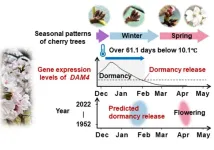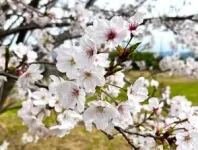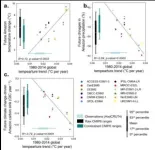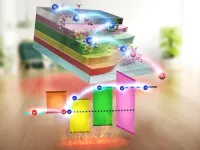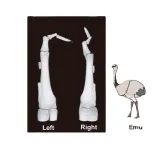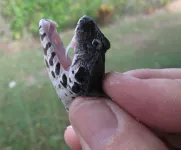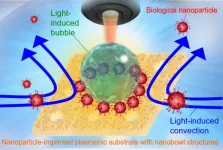Fukuoka, Japan – Japan in spring is famous for its cherry blossoms, or sakura, which begin flowering in the southern region of Kyushu and blaze upwards to the remote north of Hokkaido. The most abundant cherry tree cultivar, Somei Yoshino, is the iconic symbol of spring, as the cloned trees flower simultaneously at each site, creating a fleeting explosion of white-pink blossom that enraptures locals and tourists alike. The flowering forecasts of Somei Yoshino are poured over for months before flowering, as visitors plan their trips and locals organize festivals and celebrations. However, due to climate change, the flowering times of these cherry trees are shifting and becoming harder to predict.
Now, researchers from Kyushu University and the Forestry and Forest Products Research Institute have developed a model that uses gene activity to predict when Somei Yoshino cherry tree buds awake from dormancy. Their findings, published September 19 in the journal Plants, People, Planet, could not only help improve the accuracy of flowering forecasts, but also highlight the potential of climate change to threaten flowering in Japan’s southern region.
Before cherry trees can flower, the buds must pass through two dormancy phases, endodormancy and ecodormancy. A period of sufficiently cool temperatures over winter is needed to break endodormancy, while transitioning out of ecodormancy requires an input of heat in spring.
“This need for both cooling and heating means that flowering times can be very unpredictable,” explains first author, Atsuko Miyawaki-Kuwakado, a JSPS Research Fellow (PD) from Kyushu University’s Faculty of Science. “Depending on the temperature of autumn, winter, and spring, flowering could be early, delayed, or hindered altogether.”
When ecodormancy breaks, the buds quickly start to grow and open. But knowing when the previous stage of endodomancy has broken is tricker, as the buds show no noticeable change. However, Miyawaki-Kuwakado and senior author, Professor Akiko Satake of Kyushu University’s Faculty of Science, hypothesized that studying the inner workings of the bud could reveal the timing of this key moment.
From October onwards, the researchers took leaf and bud samples each month from Yoshino cherry trees located at three sites across Japan: Fukuoka in the south, Tsukuba in the center and Hokkaido in the north, capturing a snapshot of what genes were most active at each point in time. The researchers found that buds of Yoshino cherry trees generally passed through five main gene activity patterns, in early summer, summer, autumn, winter and spring, with each activity pattern correlating closely with temperature.
The research team then focused on the activity, or expression levels, of a subset of genes, called DAM, which are associated with bud dormancy. Out of the six DAM genes, the researchers found that DAM4 activity played a key role in maintaining endodormancy.
“We saw that at the start of winter, DAM4 was highly expressed, but as each day passed with temperatures below 10.1°C, the activity of DAM4 decreased. Once below a certain threshold, the buds awoke from dormancy and flowered when experimentally heated,” says Satake.
Using a model based on the activity of DAM4, the researchers concluded that Yoshino cherry trees require around 61 days with temperatures lower than 10.1°C for endodormancy to break. From historical temperature data by the Japan Meteorological Agency, the team then estimated that from 1990-2020, the breaking of endodormancy was delayed by 2.3 days per decade.
Moving forward, forecasters could use the estimated awakening times to improve their predictions of when the Yoshino cherry buds will flower. The researchers also plan to refine the model to predict how climate change could impact flowering.
“Without sufficient cool days over winter, endodormancy cannot break and Yoshino buds cannot flower,” says Miyawaki-Kuwakado. “Therefore, it’s important to predict the impact of global warming, particularly in Japan’s southern region, so that we can try to develop strategies to mitigate it.”
###
For more information about this research, see “Impacts of climate change on the transcriptional dynamics and timing of bud dormancy release in Yoshino-cherry tree,” Atsuko Miyawaki-Kuwakado, Qingmin Han, Keiko Kitamura, Akiko Satake, Plants, People, Planet, 10.1002/ppp3.10548
About Kyushu University
Founded in 1911, Kyushu University is one of Japan's leading research-oriented institutes of higher education, consistently ranking as one of the top ten Japanese universities in the Times Higher Education World University Rankings and the QS World Rankings. The university is one of the seven national universities in Japan, located in Fukuoka, on the island of Kyushu—the most southwestern of Japan’s four main islands with a population and land size slightly larger than Belgium. Kyushu U’s multiple campuses—home to around 19,000 students and 8000 faculty and staff—are located around Fukuoka City, a coastal metropolis that is frequently ranked among the world's most livable cities and historically known as Japan's gateway to Asia. Through its VISION 2030, Kyushu U will “drive social change with integrative knowledge.” By fusing the spectrum of knowledge, from the humanities and arts to engineering and medical sciences, Kyushu U will strengthen its research in the key areas of decarbonization, medicine and health, and environment and food, to tackle society’s most pressing issues.
About Plants, People, Planet
Plants, People, Planet is a multi-disciplinary Open Access journal, owned by the New Phytologist Foundation and published by Wiley. The journal publishes outstanding plant-based research in its broadest sense and celebrates everything new, innovative and exciting in plant-focused research that is relevant to society and people's daily lives. The New Phytologist Foundation is an independent, not-for-profit organisation dedicated to the promotion of plant science.
Links to use:
Short form for use when space is limited: plantspeopleplanet.org
For general use in hyperlinks: https://nph.onlinelibrary.wiley.com/journal/25722611
New Phytologist Foundation
newphytologist.org
END
